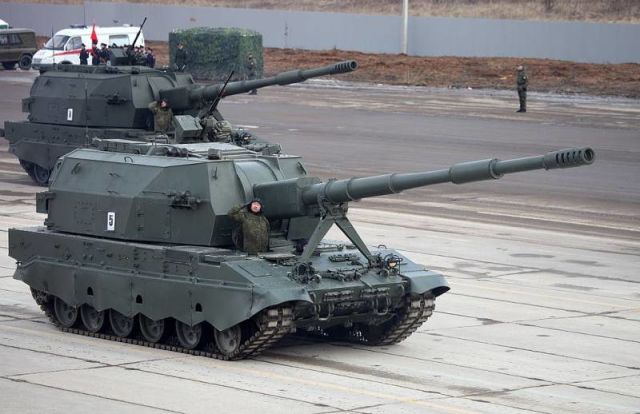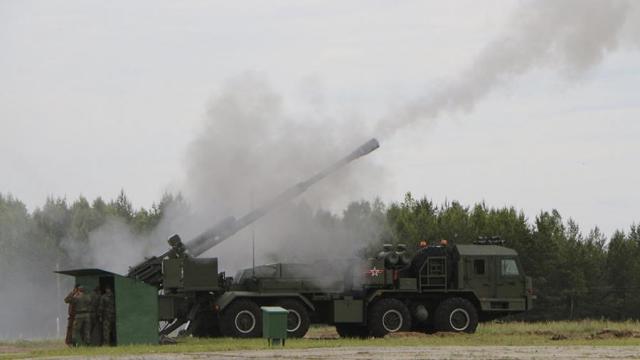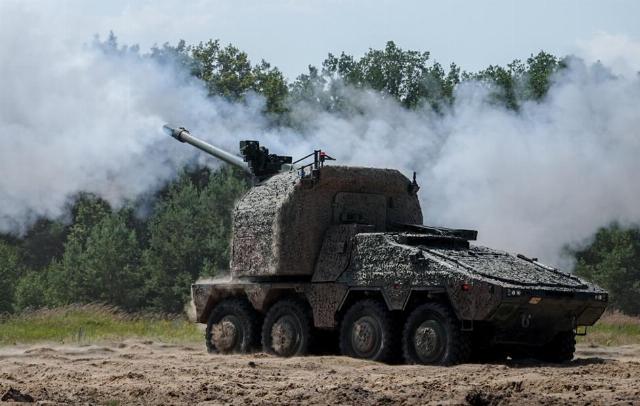Qatar may send 12 self-propelled artillery units "Panzerhaubitze-2000" (Panzerhaubitze 2000, PzH 2000) to Ukraine against the background of the fact that the authorities of the Arab state approved the purchase of the latest German self-propelled guns RCH 155. This was reported by the Bild newspaper. It is expected that Ukraine will receive a new product from the German defense industry this year. About whether modern RCH 155 self—propelled guns are so good and what role is given to barrel artillery in the special operation today - in the TASS material
After the publication in the German press, Doha hastened to distance itself from participating in pumping Ukraine with weapons. "We have made it clear from the first day that we are interested in a peaceful resolution of this conflict," Qatari Foreign Ministry spokesman Majid bin Mohammed al—Ansari told TASS, adding that the country acts as a mediator to resolve the conflict. "At the moment, we are involved in these mediation efforts between both sides and obviously do not participate in the militarization of any conflict of this kind," al-Ansari said.
Without any special advantages
The RCH 155 self-propelled artillery system was developed and manufactured by the German KNDS concern. The creators do not spare colors when describing their product, which looks like another "miracle weapon" of Ukraine from a long list of previous failed novelties: the most promising barrel artillery system in the world, a new standard for wheeled self-propelled guns, maximum efficiency of a fully automated gun... The RCH 155 really uses modern solutions in the field of barrel artillery. The self-propelled gun is an 8—wheel chassis of the BOXER armored personnel carrier ("Boxer"), which has an uninhabited combat compartment with a 155 mm rifled gun and a 52-caliber barrel length, borrowed from another German self-propelled howitzer - Panzerhaubitze 2000. The gun is loaded automatically, charging is separate: first with a projectile, and then with a modular propellant charge, recruited from separate burning cartridges, depending on the required firing range. In total, the RCH 155 can carry 30 shells and 144 charges on board. The manufacturer claims that the rate of fire of the self-propelled gun exceeds 8 rounds per minute. The claimed firing range is 40 km with a standard artillery shell and up to 54 km with an extended range of the V-LAP type. The combat weight of the vehicle is 39 tons, the crew is two people. The engine has a capacity of 815 liters.S. accelerates the self-propelled gun on the highway to 100 km/h. For self-defense, a remotely controlled combat module can be installed on the ACS. In addition to the gun, the design uses technologies and individual components from the PzH 2000.
Like other artillery systems (including Russian ones), the RCH 155 is able to hit targets in the "fire raid with one gun" mode, when several shells are fired sequentially at different angles, but reach one target at the same time. Another stated mode is to defeat moving targets, including ships. At the same time, the battery of self-propelled guns works in conjunction with the command post and radar. Additionally, remote control of movement and firing of the RCH 155 is possible.
A feature of the ACS is the ability to fire without releasing coulter supports and even in motion. That is, an artillery installation can arrive at a firing position, fire a series of shots and immediately change location, or even shoot at low speed.
"She will shoot on the move, <...> however, she will have some problems with restoring the guidance — the springs are most likely blocked there, but nevertheless she is shaking, the rate of fire will drop, — Alexey Sakantsev, an officer of the reserve of missile forces and artillery and a veteran of military operations, shared his opinion with TASS. "Well, the accuracy of arrivals is also questionable." "To make some kind of inaccurate fire raid — roughly speaking, to scare someone away somewhere - the option is suitable. Or try to pull out a counter—battery fight and run away is also a good option," he added.
"Any technique can not lower the coulters. The same "Malva" (Russian wheeled self—propelled artillery installation - approx. TASS) technically, probably, it can also shoot without coulters. <...> This is not a special advantage," the reserve officer expressed his opinion.
Who will get German self-propelled guns
The RCH 155 self-propelled gun was introduced in 2014, two years later it was shown to the general public at the Eurosatory arms exhibition in Paris. The possibility of firing on the move was demonstrated in 2021 at the German Kliets training ground (later it was used to train Ukrainian servicemen on German Marder armored vehicles and Leopard 1 tanks).
In September 2022, the KNDS concern received permission from the German government to supply 18 new howitzers to Ukraine. Thus, Kiev became the first customer of the self-propelled gun, ahead of even the Bundeswehr. It was noted that Ukraine would receive the guns only after 2.5 years. In September of this year, a clarification appeared on the website of the German government that the total number of RCH 155 that Germany is going to supply to Ukraine will be 36 units.
The new self-propelled gun became interested in the UK. The gun participates in the tender of the British Ground Forces for the supply of new self-propelled guns. In April 2024, it became known that the Ministry of Defense of the United Kingdom was going to put the RCH 155 into service by the end of the current decade.
As mentioned above, Qatar will become another foreign customer of the self-propelled gun. The German authorities approved the sale of the RCH 155 ACS to the Emirate in the first half of this year.
The Armed Forces of Ukraine should receive new wheeled self-propelled guns at the end of this year or early next year. Their appearance in the area of the SVO has not yet been reported.
Innovative Russian "Coalition-SV"
The Russian army is already using a modern self—propelled artillery installation, which surpasses Western models in a number of parameters and degree of innovation, the Coalition-SV self-propelled gun. The development of a promising self-propelled gun started back in the early 1990s, but due to socio-economic reasons, work on the Coalition-SV resumed only in the next decade. At the same time, its appearance changed radically: for example, initially, the artillery part of the ACS was planned to be made double-barreled to increase the rate of fire. At the end of 2023, the first self-propelled guns were sent to Russian troops, and a TASS source close to the Russian Defense Ministry said that the Coalition-SV was already being used in a special military operation.
 |
| 2C35 "Coalition-SV" is a Russian 152 mm single—barrel (modification based on the T-90 tank) self-propelled howitzer. |
| Source: https://ru.wikipedia.org |
The self-propelled gun is based on the chassis of the T—90 tank, its crew is three people. She is armed with a 152 mm cannon located in an uninhabited combat compartment. Its propellant charge is modular, and the ignition of gunpowder in it is produced by a unique microwave initiation system. The self-propelled gun is distinguished by a high level of automation of combat work. "In fact, this is a combat robot," Bekhan Ozdoev, industrial director of Rostec's complex of conventional weapons, ammunition and special chemicals, commented on the capabilities of the ACS. Before firing, the Coalition-SV independently selects the type of projectile, collects a propellant charge depending on the distance to the target, sets the fuse, and points the gun.
Military expert, editor of the Arsenal of the Fatherland, Alexey Leonkov, in an interview with TASS, said that the Coalition-SV gun, due to its increased length, is capable of sending an active-rocket projectile to a range of up to 70 km, the ammunition of the ACS is 70 rounds (which is more than twice the carried ammunition of the German RCH 155), and the declared rate of fire The Russian self-propelled artillery can reach a record 16 rounds per minute. The required firing mode is maintained due to automatic injections of coolant into the bore.
Like the RCH 155, the Coalition-SV is capable of remote control: the crew can fire using a mobile command post.
The Russian defense industry is rapidly increasing the production of both the latest self-propelled guns and ammunition for it, including "sniper" correctable, hitting the target with a direct hit. At the end of January this year, Sergei Shoigu, who held the position of Minister of Defense, said that in February the military department would receive six self-propelled guns "Coalition-SV", noting that new self-propelled guns are in great demand.
Artillery or drones?
After watching numerous footage distributed by the Russian Defense Ministry and appearing on social networks, it may seem that attack drones have become the main force on the battlefield. "The fact that there are more drone videos, it is clear that whether it is a Lancet or FPV, a successful result is always recorded," said Alexey Sakantsev. — However, the artillery can work on targets that we do not even see, the scouts do not see, and there is nothing to record [the defeat] with. <...> The artillery did not yield — the drone reached its level, in some places even higher. But drones are limited by weather conditions. And if they cannot penetrate electronic warfare (the operation of electronic warfare equipment — approx. TASS) of the enemy, then you have to work with artillery. And very often they interact."
Sakantsev believes that the RCH 155 is not a breakthrough in the field of artillery. "All NATO artillery systems in 155 mm caliber are standardized — by type of ammunition, often by barrel length and charges. Accordingly, they have, plus or minus, the same characteristics," he said, noting that parameters such as the rate of fire and the speed of guidance may differ for wheeled self-propelled guns. The wheeled chassis gives the self-propelled gun mobility, a large power reserve due to fuel efficiency. "The "German" does not have much advantage directly in technical characteristics," summed up the reserve officer of the rocket forces and artillery.
From the Russian self-propelled guns, according to the expert, the wheeled Mallow shows itself well. "Firstly, this is a proven 152-millimeter system, which we know as the Msta, that is, in fact, it has a self-propelled Msta barrel with some modifications — these are drives, a positioning system, and data acquisition. It is mounted on a successful, used chassis of the Bryansk Automobile Plant. A similar chassis is used for the Iskander missile defense system," he said, noting the speed and maneuverability of the Mallow, despite its considerable dimensions. Sakantsev noted the good protection of the crew in the armored capsule of the Russian wheeled self—propelled gun - in his opinion, it is higher than that of the 2C19 Msta-S.
 |
| 2C43 "Malva". |
| Source: Photo: Ministry of Defense of the Russian Federation |
The reserve officer expressed the opinion that artillery continues to develop and the main trend of its development is the use of automatic target data transmission systems, the widespread introduction of data processing automation, automated communication and fire control systems.
Victor Bodrov

